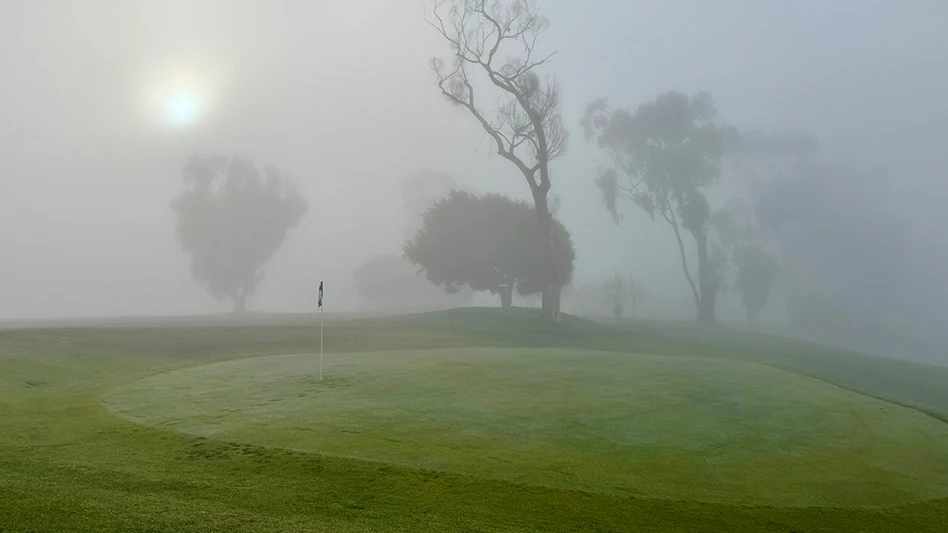Surface runoff is one of the largest loss mechanisms for pesticides applied to turfgrasses (Smith and Bridges, 1996; Lee et al., 2000). Considering the importance of turfgrass to urban environments and the need to protect water quality, there’s an ongoing need to perform turf runoff experiments to assess the behaviors of new chemicals or products, refine best management practices and calibrate/validate runoff prediction models for turfgrass.
Field studies indicate surface runoff from creeping bentgrass (Carroll, 2007) and Bermudagrass (Massey, 2007) is scalable across a range of plot areas. Thus, there’s solid scientific justification for using plot-scale experiments to study the surface runoff of turf chemicals.
Conceptually, conducting a turf runoff experiment is simple. A chemical is applied to grass, and runoff, generated by natural or simulated rainfall, is collected and analyzed for the chemical. In practice, a runoff study involves a number of steps that must be performed carefully to ensure scientifically valid, representative data are produced. Seemingly small oversights in study design or conduct might compromise data from a scientific or regulatory perspective.
The goal of the experiment is to assist researchers, and perhaps those charged with evaluating/interpreting runoff study designs/results, by highlighting certain quality control considerations important to the conduct of a plot-scale turf runoff experiment. The experiment isn’t comprehensive, but it presents quality control approaches that have proven helpful in studies conducted at Mississippi State University.
For a review of technical considerations important to the conduct of a runoff study, review Wauchope et al. (1995). The experiment phases addressed are:
- Study planning,
- Plot construction and maintenance,
- Rainfall simulator verification,
- Application monitoring, and
- Sample handling.
Study planning
Quality control principle. A detailed study protocol that addresses all aspects of study conduct is critical to the success of any study. Moreover, an approved protocol is required for a study to be submitted to support pesticide registration. A well-designed protocol serves as an invaluable reference throughout a study as many construction and study conduct activities build on one another.
Basis of concern. There are certain study details that shouldn’t be left to chance or addressed as an afterthought once the study is under way. Particular attention should be paid to methods used to control and account for water movement in test plots and methods used to account for pesticide application and rate in the turf system. Some pesticides present special considerations, such as those with a propensity to adsorb to plastic and other surfaces strongly (water solubility equals 1 milligram per liter at 25 Celcius), rapidly degraded (soil T1/2 equals two days), or those that are relatively volatile (vapor pressure greater than 10-4 millimeters of mercury at 25 Celcius). Thus, the researcher must take into account the properties and environmental behavior of the pesticide during protocol development. Sample handling and storage practices also are critical and often compound-dependent.
Approach. A thorough literature review is an appropriate place to begin a study of this scale. Unfortunately, quality control programs aren’t always explicitly reported in published works. Consultation with the chemical manufacturer, other researchers and the targeted end-user of the information generated by the study can help address important aspects of study design. In the end, attempting to account for as much of the rainwater and applied pesticide as possible is a good guiding practice in study design and conduct.
Turf plot construction, maintenance
Quality control principle. The runoff plot should be constructed to capture no more and no less than the actual runoff occurring from the treated
plot. Water external to the plot boarders shouldn’t be allowed to run onto the treated plot just as the runoff collection apparatus must capture all surface runoff and not leak.
Basis of concern. If water external to the treated plot is allowed to run onto the plot, pesticide concentrations in runoff will be diluted. Runoff that completely bypasses or leaks from the runoff collection apparatus before measurement will reduce the total runoff volume and pesticide load measured during the study. Both of these scenarios won’t accurately reflect the actual amount of runoff that occurred.
Approach. To prevent extraneous water from entering the plot, the plot must be isolated hydrologically from the surrounding area using metal dykes (Wauchope et al., 1990), landscape timbers (Smith and Bridges 1996; Hong and Smith 1997) or flexible plastic discharge hoses filled with masonary sand (Cole et al., 1997). However, for multiple plots, it might be better to use permanent turf-covered soil berms because they are easy to maintain by mowing when less than two inches high.
Plot spacing also is important and dependent on overall experimental design and configuration of the spray equipment and rainfall simulator to be used. Wide plot spacing prevents overspray during pesticide application and rainfall simulation and allows movement of equipment between multiple plots. Knowledge of the distance of throw of the rainfall simulator is needed to determine appropriate plot spacing.
One of the most important considerations in plot construction and maintenance is the interface that exists between the down-slope edge of the plot and the runoff collection apparatus. This interface between the runoff diverter and turf is critical because it represents a potential point of loss for surface runoff. Wauchope et al. (1995) note construction of the diverter-turf interface requires creativity and skill. Several approaches might be used, but in each case, the system must ensure against runoff bypass and potential leaks.
At Mississippi State, we thought it was best to minimize the transition between the sod and diverter by minimizing the thickness of the diverter. Our diverter consisted of 20-gauge aluminum metal bent to a 140-degree angle. The diverter was designed so that it extended into the plot about two inches and into the runoff collection trough about three inches. The soil underneath the diverter was sieved, carefully leveled and tamped so no air space existed under the diverter. Next, the diverter was attached to a wooden box lining the collection trench using silicone sealant and screws with rubber grommets. Before installing the diverter, sod close to the interface was removed using a sod cutter.
Once the diverter was installed, the original sod was placed so that it overlapped the diverter about one inch. The diverter-sod interface was allowed to heal for six to eight weeks before leak testing the remaining portion of the runoff collection system using turf marker dye.
Rainfall application rate verification
Quality control principle. The delivery rate and uniformity of the rainfall simulator must be verified under field conditions.
Basis of concern. Rainfall application rates significantly less or greater than the target rate and/or lacking in uniformity might cause nonrepresentative and/or highly variable results that complicate interpretation.
Approach. Before conducting runoff studies, the performance of the rainfall simulator must be verified. This is accomplished using a formal audit procedure (Wauchope et al., 1995). For example, Carroll (2005) used paper cups spaced on 12-inch centers. Plastic tarps placed over the entire plot area might be used to determine total rainfall delivery. This approach provides a visual assessment of uniformity but doesn’t yield a quantitative measure of rainfall uniformity.
The operating pressure of the simulator should be noted during audits and checked periodically during study conduct to ensure the system is operating properly. During runoff events, pan-type rain gauges should be used to record rainfall amounts and uniformity. Note that tall, narrow-top rain gauges might not measure rainfall accurately, causing the steep descent of the artificial raindrops.
Pesticide application monitoring
Quality control principle. One must know the amount of pesticide applied to turf rather than assuming the nominal rate was applied to accurately calculate the percentage of chemical that occurs in runoff and ensure the pesticide concentrations measured in runoff reflect those that would occur with labeled applications.
Basis of concern. In field experiments involving pesticide application, it’s not uncommon for application rates to differ by plus or minus 15 percent or more from nominal rates, even after careful calculation, calibration of spray equipment and application by experienced people (ACPA, 1996; Mojasevic and Helling, 1998). In an analysis of more than 1,600 pesticide applications, improper boom height (60 percent of errors), miscalculation of application rate (26 percent) and variation in pass time (14 percent) were most responsible for inaccurate application rates (Braverman et al., 2001).
Approach. Three main approaches are used to verify pesticide application rates (Massey et al., 2002). Two indirect measures are the catch-back method and the pass-time method. The catch-back method involves measuring the spray solution volume before and after application to determine if the desired volume of test solution was applied to the test plots. The pass-time method involves measuring the time it takes the applicator to pass over the test plot having known length and comparing this time to the speed used in calculation.
Experienced applicators are able to apply within plus or minus 2 percent of the targeted spray volume or pass time. Making several practice runs before each pesticide application improves overall accuracy.
Field protocols written for regulatory purposes typically require the application to be within plus or minus 5 percent of the target spray volume or pass-time value. Variances exceeding these criteria should be scrutinized closely, and the cause of the misapplication determined before proceeding with additional applications.
A direct measure of deposited residues uses application verification monitors, which are paper discs, polyurethane foam plugs, Petri dishes, etc., placed in the test plot to collect spray deposition that occurs during application. The application verification monitors are collected and analyzed chemically for the test chemical(s) being applied. Prelabeled monitors are positioned before application in an arrangement spanning the length and width of the plot to allow a representative sample of the spray pattern. We used about one application verification monitor per 100 square feet of plot area.
Immediately after application, the monitors are collected and handled carefully so as to not lose pesticide content, wrapped in aluminum foil and immediately frozen until analyzed. Care also must be taken to not walk on or otherwise disturb treated turf surfaces after application. A catwalk might be helpful to prevent plot disturbance when retrieving the monitors.
If, after analysis, the pesticide contents of the individual application verification monitors are found to vary by more than 20 percent within an application, the source(s) of the variability should be determined and reduced to ensure uniform pesticide treatment in future studies (Massey and Lenoir, 2003).
Sample handling, storage
Quality control principle. The application monitors and runoff samples must be labeled, handled, and stored properly to preserve the scientific integrity of study results.
Basis of concern. Improper handling and storage of samples can result in unacceptable degradation losses and compromise the integrity of the samples and, thus, the scientific validity of the overall study.
Approach. The collection of application monitors should begin immediately after application and the samples stored frozen to stabilize residues and solidify liquid spray droplets to prevent spills. Provisions should be made to have ample help to collect the application monitors, recognizing labor requirements rise with plot size and the number of monitors used.
A ‘dry run’ collecting the application verification monitors helps assess the time needed to collect, wrap and store the monitors. Runoff samples should be placed on ice during or immediately after collection and transported on ice back to the laboratory. Ideally, a robust, sensitive analytical method would be in place before initiating the field-conduct phase of a runoff study as this assures timely analysis of samples. However, if the samples can’t be analyzed soon after collection, it’s best to analyze at least a subset of the initial runoff samples. These samples then would be frozen along with the remaining unanalyzed samples and reanalyzed when the remainder of samples is analyzed. By comparing the initial and final analyses of these samples, the storage stability of pesticide residues in the later-analyzed samples can be determined.
Account for rainwater
Much planning, effort and expense are associated with the conduct of a pesticide runoff experiment. While all aspects of the study are important, several are of critical importance to overall outcome of the study. Perhaps the best way to summarize the approach encouraged is to strive to account for as much of the rainwater and applied pesticide as possible. GCI
Joe Massey, Ph.D., is associate professor in the department of plant and soil sciences at Mississippi State University. Credit USGA Turfgrass and Environmental Research Online (ISSN 1541-0277), Volume 7, Number 5.
Literature cited
1. American Crop Protection Association (APCA), 1996. Workshop minutes, “Zero-time residue levels in field soil dissipation studies.” Crystal City, VA.
2. Braverman, M.P., J.S. Corley, D.C. Thompson, M. Arsenovic, V.R. Starner, K.S. Samoil, F.P. Salzman, D.L. Kunkel, and J.J. Baron, 2001. Proc. Weed Sci. Soc. Amer., 41, 17.
3. Carroll, M. 2005. Personal Communication. University of Maryland. College Park, MD.
4. Carroll, M. 2007. Turfgrass Runoff Investigations: Does Plot Size Matter? USGA Turfgrass and Environmnetal Research Online. 6(24):1-7.
5. Cole, J.T., J.H. Baird, N.T. Basta, R.L. Huhnke, D.E. Storm, G.V. Johnson, M. E. Payton, M.D. Smolen, D.L. Martin, and J.C. Cole. 1997. Influence of buffers on pesticide and nutrient runoff from Bermudagrass turf. J. Environ. Qual. 26:1589-1598.
6. Hong, S. and A.E. Smith, 1997. Potential movement of dithiopyr following application to golf courses. J. Environ. Qual. 26:379-386.
7. Lee, Young-Duek, Hyun-Ju Kim, and Jong-Bae Chung, 2000. Loss of pendimethalin in runoff and leaching from turfgrass land under simulated rainfall. J. Agric. Food Chem. 48:5376-5382.
8. Massey, J.H., S.H. Jackson, M. Saha and E. Zietz, 2002. Soil Sampling and Analysis. Chapter 8.4 In Handbook of Residue Analytical Methods for Agrochemicals. P. Lee (ed.). pp. 840-891. John Wiley & Sons Ltd.
9. Massey, J.H. and J.S. LeNoir, 2003. Sources and Magnitudes of Variability in Terrestrial Field Dissipation of Pesticides. Chapter 6 In Terrestrial Field Dissipation Studies: Design, Interpretation and Purpose. E. Author et al. (eds.) ACS Symposium Series No. 842. American Chemical Society, Washington, DC.
10. Massey, J. 2007. Bridging the Gap: Effect of Plot Size and Warm-Season Grass Species on Turf Chemical Runoff. Annual report to the United States Golf Assn. Stilwater, OK
11. Mojasevic, M., and C.S. Helling, 1998. 9th Int. Cong. Pestic. Chem., IUPAC, Abstr. No. 2:7C-049.
12. Smith, A.E; D.C Bridges, 1996. Movement of certain herbicides following application to simulated golf course greens and fairways. Crop Sci. 36: 1439-1445.
13. Wauchope, R.D.; R.G. Williams; L.R. Marti, 1990. Runoff of sulfometuron-methyl and cyanazine from small plots: Effects of formulation. J. Environ. Qual. 19:119-125.
14. Wauchope, R.D., R.L. Graney, S. Cryer, C. Eadsforth, A.W. Klein, and K.D. Racke,1995. Pesticide runoff: Methods and interpretation of field studies. Pure & Appl. Chem 67: 2089-2108.

Explore the April 2008 Issue
Check out more from this issue and find your next story to read.
Latest from Golf Course Industry
- Beyond the Page 65: New faces on the back page
- From the publisher’s pen: New? No way!
- Indiana course upgrades range with synthetic ‘bunkers’
- Monterey Peninsula CC Shore Course renovation almost finished
- KemperSports and Touchstone Golf announce partnership
- PBI-Gordon Company hires marketing manager Jared Hoyle
- Mountain Sky Guest Ranch announces bunker enhancement project
- GCSAA names Joshua Tapp director of environmental programs





